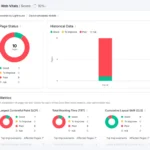
Introduction
Have you ever searched for something on Google and seen a highlighted box at the top of the results that instantly answers your question?
That’s a featured snippet — often called “Position Zero.”
For SEO professionals, getting your content into featured snippets can be a game-changer. It boosts visibility, increases click-through rates, and establishes your brand as an authority in your niche.
In this guide, we’ll break down what featured snippets are, the types you can target, and how to optimize your content to win them in 2025’s evolving search landscape.
1. What Are Featured Snippets?
Featured snippets are special boxes that appear above the regular search results on Google. They provide quick, direct answers to user queries, extracted from top-ranking web pages.
They come in several formats:
- Paragraph snippets: Short text answers (common for definitions, “what is” queries).
- List snippets: Ordered or unordered lists (common for “how to” steps or top lists).
- Table snippets: Display data or comparisons.
- video snippets: Embedded YouTube videos for tutorials or visual guides.
Example:
If you Google “how to do an SEO audit,” you might see a concise step-by-step list — that’s a list featured snippet.
2. Why Featured Snippets Matter for SEO
Optimizing for featured snippets is one of the fastest ways to boost your organic visibility without increasing backlinks or ad spend.
- Here’s why they’re valuable:
- Higher Click-Through Rates (CTR): Snippets attract immediate attention.
- Brand Authority: Google highlights your content as the best answer.
- Voice Search Optimization: Most voice assistant responses come from featured snippets.
- More SERP Real Estate: Your page appears above the first organic result — Position Zero.
Even if users don’t click, featured snippets improve your brand visibility and trust factor dramatically.
3. Types of Featured Snippets You Can Target
To win featured snippets, you need to understand which type best fits your content.
a. Paragraph Snippets
- Format: 40–60 words
- Example query: “What is semantic SEO?”
- Optimization tip: Use a clear definition within the first 100 words of your post.
b. List Snippets
- Format: Bulleted or numbered lists
- Example query: “Steps to optimize for Core Web Vitals”
- Optimization tip: Use proper heading hierarchy (H2, H3) and HTML list tags
<ol>or<ul>.
c. Table Snippets
- Format: Comparative or data-driven
- Example query: “SEO tools comparison”
- Optimization tip: Use structured HTML tables and descriptive headers.
d. Video Snippets
- Format: Embedded video previews
- Example query: “How to set up Google Analytics”
- Optimization tip: Add timestamps and detailed captions in your video descriptions.
4. How to Find Featured Snippet Opportunities
Before optimizing, identify which queries already trigger snippets in your niche.
Step 1:
Use tools like Ahrefs, Semrush, or Surfer SEO to find keywords with featured snippets.
Step 2:
Look for:
- “What is…” or “How to…” queries
- Comparison keywords (“vs.”, “best”, “top”)
- FAQ-style searches
Step 3:
Target long-tail keywords — they’re more likely to trigger featured snippets and face less competition.
Example:
Instead of targeting “SEO,” go for “how to do an SEO audit step by step.”
5. How to Optimize for Featured Snippets
Winning a featured snippet requires both content structure and clarity.
Here’s how to make your content snippet-ready 👇
a. Understand the Search Intent
Determine what users actually want from the query — a definition, list, table, or how-to.
Example:
- “What is” = Paragraph snippet
- “Steps” or “How to” = List snippet
- “Comparison” = Table snippet
b. Structure Your Content Clearly
Google extracts content that’s easy to understand and scan.
- Use descriptive headers (H2, H3)
- Include short paragraphs (40–60 words)
- Add lists and tables where relevant
- Use schema markup (FAQ, HowTo, or Article Schema)
Tip: Answer the target query in a single paragraph, then expand with details below it.
c. Optimize for Featured Snippet Keywords
- Place your target keyword (featured snippets) in:
- Title
- First 100 words
- One H2 or H3
- Meta description
Use semantic keywords like:
- position zero
- paragraph snippets
- SEO snippets
- Google featured snippets
d. Answer Questions Directly
Google loves concise, factual answers.
Format answers as:
“A featured snippet is [definition]…”
“To optimize for featured snippets, follow these steps…”
You’re helping Google lift that sentence directly into the snippet box.
e. Add Visuals and Media
Include images, screenshots, or short videos that explain processes visually.
Google often prefers visually supported results for “how-to” snippets.
f. Use Internal Link
Connect your snippet-targeting articles to related content.
Example: Link your “Featured Snippets” article to:
- How to Optimize for Google’s AI Overviews
- SEO Tools for 2025
- Semantic SEO Explained
This builds topical authority and increases your chance of being cited in AI-driven search results.
6. Track and Measure Snippet Performance
Once your content is live, monitor your performance using Google Search Console.
Look for:
- Keywords triggering featured snippets
- CTR improvements
- Impressions for snippet-related queries
You can also use Semrush → SERP Features Report to see how many snippets you’ve captured.
7. Bonus: Common Mistakes to Avoid
- Writing long, unclear answers
- Ignoring formatting (no lists, no headings)
- Targeting queries that already belong to strong competitors (Wikipedia, Google)
- Keyword stuffing or over-optimization
Rule of thumb: Always optimize for clarity, structure, and user intent.
FAQs About Featured Snippets
1. What are featured snippets in SEO?
Featured snippets are highlighted search results that provide direct answers at the top of Google’s SERP, extracted from high-quality pages.
2. How can I rank for featured snippets?
Structure your content clearly, use headings, answer questions concisely, and target long-tail keywords.
3. Are featured snippets good for SEO?
Yes — they improve visibility, CTR, and authority, helping you reach Position Zero on Google.
4. How long should featured snippet answers be?
The ideal length for a featured snippet paragraph is between 40 and 60 words.
5. Do I need backlinks to win a featured snippet?
Not always. Strong content structure and relevance can help you outrank even higher-authority domains.
Conclusion
In 2025, featured snippets remain a powerful way to capture attention and authority in Google Search.
By answering user questions directly, structuring your content clearly, and using schema markup, you can earn Position Zero — even against stronger competitors.
Remember: snippets are about clarity and value, not just keywords.
Start optimizing your content today and let your expertise take center stage at the top of Google.





